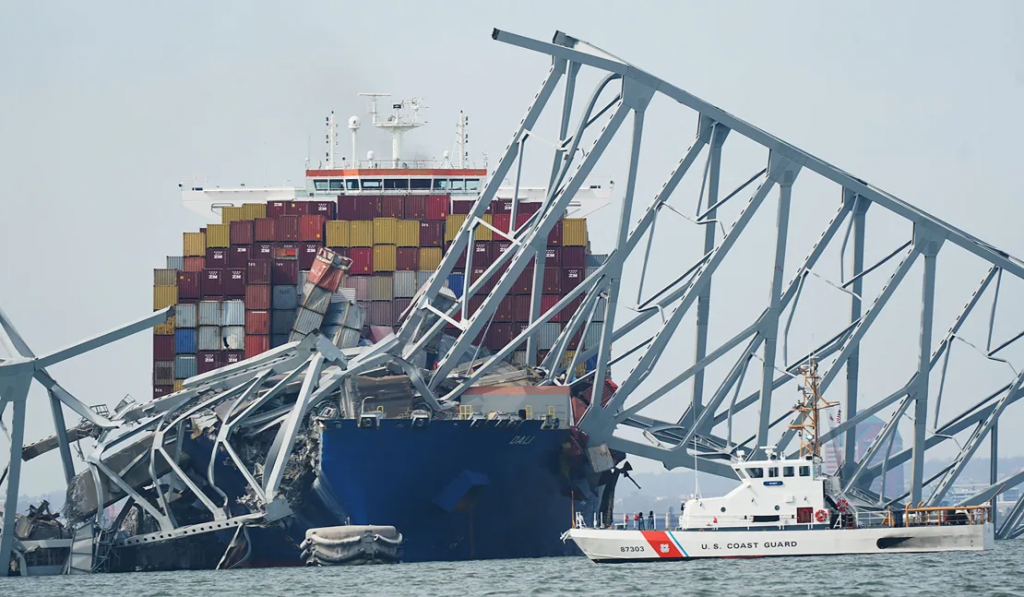Hong Kong — A deadly bridge collapse in Baltimore. A bridge in southern China sliced in half. Parts of a bridge cutting through the hull of a massive ship in Argentina.
These events all happened within the first three months of this year – and all after collisions with large commercial ships.
These incidents, and the toll – with at least five killed in China, and six still missing in Baltimore – have highlighted what experts say is the urgent need to improve or protect old bridges to accommodate larger modern vessels.
The Baltimore collapse on Tuesday focused national attention on the issue, after a large container ship lost power and crashed into the Francis Scott Key Bridge, sending people and vehicles into the frigid Patapsco River.
“We need to remember this bridge was built 50 years ago, and the ships at the time were a fraction of the size of what DALI (the ship that crashed) is today,” said Sal Mercogliano, a former merchant mariner and maritime expert.
“And DALI isn’t even a big container ship, there are much larger vessels that are out there,” he added. “So in many ways we have infrastructure that was built for another time.”
‘Very high possibility’ of collisions
The incident in China took place late February when a cargo ship rammed into the Lixinsha Bridge in the Pearl River Delta, southern Guangzhou province – a major international shipping hub and the country’s industrial heartland.
Dramatic photos of the aftermath showed the bridge split in two. State-run broadcaster CCTV reported that reinforcement work on the bridge due to structural concerns had been repeatedly postponed in recent years.
And a month earlier, a large cargo ship collided with the Zárate–Brazo Largo Bridges crossing the Prana River in Argentina, according to now-shuttered government-run news agency Télam – severely damaging the ship, though the bridge remained intact.
Though on paper these incidents may look similar – a big ship hitting a bridge – there could be varying factors at play, said Bassem O. Andrawes, a professor of structural engineering at University of Illinois at Urbana-Champaign and an expert on bridge collapses.
For example, the incident in China appears to show the vessel hitting the body of the bridge, rather than its piers – the vertical columns holding up the structure – indicating, “the ship had a certain height that was ignored,” or the river may not have been “right for such large vessels,” said Andrawes. “That could be human error.”
Preliminary investigations into the collision also suggest it was caused by “inappropriate conduct by the vessel’s crew,” according to state-run outlet China Daily.
By contrast, in the Baltimore example, the water channel and bridge are wide and tall enough to accommodate large vessels – and the cargo ship hit the bridge pier, not the bridge itself, Andrawes said.
“There are different causes for all these instances,” he added. “But there is actually now more awareness that there is a possibility, and it’s not a slim chance, but a very high possibility, that a vessel would strike part of the bridge – whether that’s the pier or the superstructure.”
When vessels do strike bridge piers, it can be “catastrophic,” because that’s the weakest point of the bridge, he said.
He pointed to the 1980 collapse of the Sunshine Skyway Bridge in Florida after being hit by a freighter, killing 35 people.
That incident prompted the engineering and transportation community to “really look at how to design piers that can withstand that,” he said.
Need for better infrastructure
There are ways to prevent these kinds of disasters – or at least to minimize the damage.
Additional structures like bumpers can be added to bridges, under the water and out of sight, deflecting ships that veer too close, Andrawes said.
Many ports and waterways also use “dolphins” – structures rooted in the seabed or riverbed, extending above the water, typically made from timber or steel. While these are often used as a mooring point for vessels, they can also protect bridges from being hit by ships – with the Sunshine Skyway Bridge implementing many “dolphins” around each pier when it was rebuilt.
Andrawes added that bridges should be built with “redundancies” in their design – so that when one element fails, like a pier that’s been hit, other features can bear the load.
But even these measures can only do so much in the event of a large cargo ship collision, Mercogliano said, pointing to the Baltimore collapse.

Steve Helber/AP
As reported by CNN
